The Warman Brewery in Newport Pagnell (July 1906 – August 1909)
In collecting old local bottles and flagons, it became apparent that those marked “E. L. Warman, Newport Pagnell” were some of the rarest and hardest to find. He only ran the Cannon Brewery in the town for just over three years, so I decided to find out what I could about where he had come from, his time in charge and what happened to him afterwards. I wasn’t expecting to find very much…. Next time you are having a drink in The Cannon, raise a glass to Edgar.
Introduction
Born 12th April 1880 and baptised 8th May at Holy Trinity, Slad, Stroud, Edgar Leslie Warman was the middle son of William and Margaret Warman, having two brothers and two sisters. The family home was “Woodlands”, a large house on Slad Road, Stroud, where William was a solicitor. Margaret was noted in a later census as having been born in Valparaiso, Chile, but was a “British Subject”. All three boys were educated at the exclusive Bradfield College, west of Reading, in Berkshire. Here, they seemed to excel at sports. Edgar attended 1894-8 and was in the Football XI for 1896-7 and the Cricket XI 1897-8, as well as being a Prefect. William Frederick Buckland Warman, his elder brother, featured in the school cricket team too. Edgar and William jnr. also played for Stroud Cricket Club c.1900.
In the 1901 census, taken when Edgar was 21, he was still living at home and gave his profession as “Articled clerk to solicitor”, presumably at his father’s firm. While William jnr. went on to become a solicitor like his father and eventually take over the family firm and Bertram Dudley Seager Warman, the youngest brother, became an architect and travelled to South America, it appears that Edgar had decided he was more interested in beer.
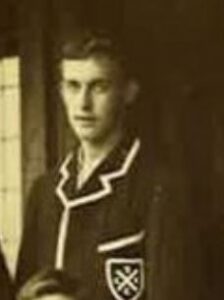
By January 1903, he had moved to Newbury in Berkshire and was involved in Newbury Cricket Club as Honorary Secretary and Sub-captain, the local tennis club and also in theatrical shows for the local St. John’s Sunday School and others in aid of the cricket club. It looks like he had a position with a local brewer there, as an E. Warman attended a meeting of local brewers to discuss changes to the Licensing laws in March.
1904
Edgar Leslie Warman’s involvement with the Cannon Brewery at Newport Pagnell starts with a death; that of the previous owner, John Robert Wilmer, in 1904.
The Wilmer family came to Newport Pagnell from Gayhurst. The had bought and established the Cannon Brewery by 1860, although a John Wilmer had had dealings in the same site back to 1846 when it had been a bakers and grocers. In 1861, John Wilmer and three of his brothers were living and working at the brewery. They put their adverts in local papers upside down, an early example of clever marketing! By 1866, it had become ‘Wilmer & Sons’ as his sons grew up and a mineral water works was added in 1891, catering for the surge of beer alternatives needed during the Temperance movement.
John Wilmer passed away 7th June 1904, aged just 63, at his brother-in-law’s house in North Finchley, London. He had held many local public offices and been a local magistrate, as well as chair of the Board of Guardians, the North Bucks Victuallers Association and the Newport Pagnell Conservative Association. He was also connected with Newport Pagnell Church Institute. The report of his funeral in the Bucks Standard of 18th June filled more than an entire column. The coffin was collected from Newport Pagnell Railway Station and conveyed to Gayhurst for burial. All the shops closed for the day, and principle houses had their blinds closed as a mark of respect. He left an estate of £10,724, which would equate to about £700,000 now. The Cannon Brewery was offered by the family to Phipps & Co., brewers of Northampton, but they declined.
1905
Arrangements were soon underway by his executors to sell off the brewery and other premises in Newport, which was advertised in the Bucks Standard on 11th March 1905. They were unusual in not having a tied estate of pubs, except for the reference to a beer-house at Simpson:
“Preliminary. Newport Pagnell, Bucks. Important to Brewers, Wine and Spirit Merchants and others. J. P. GOODWIN Begs to announce that he has received instruction to sell by auction, at the Swan Hotel, Newport Pagnell, on Wednesday, the 12th of April, 1905 at Five o’clock in the afternoon precisely, as a going concern,
All that Valuable Brewery and Premises at Newport Pagnell known as “THE CANNON BREWERY,” the MINERAL WATER FACTORY adjoining, the EXTENSIVE WINE and SPIRIT STORES adjoining, and the Fully-licenced HOUSE and Premises attached, being No.50, High Street,
All that Freehold BEER-HOUSE, CORN MILL, and premises, known as “The Lock House,” Sympson, near Fenny Stratford, Bucks.
A Valuable Plot of GARDEN GROUND and COTTAGE adjoining, being No.5, Priory-street, Newport Pagnell.
24 Fully-paid £4 SHARES in the Newport Pagnell Gas and Coke Company, Limited.
10 £1 Preference SHARES in the Newport Pagnell Church Institute and Masonic Hall Co., Limited, and 20 £1 Ordinary Shares in the same.”
The auction for the 5-quarter brewery duly took place and a report of the proceedings appeared in the Bucks Standard on 15th April. The first lot put up was the Priory Street cottage and garden, which attained a bid of £240, but the reserve was not reached. The Brewery too was withdrawn after attracting only one bid of just £2000. The Lock House at Simpson was sold for £600 to George Sampson, who was the Wilmer’s brewery manager. The Shares, after being split into small lots, all found new homes. So for more than a year, the business continued to be run as Wilmer’s Brewery by its staff, under direction of the late John Wilmer’s executors.
1906
In March, the brewery was again offered to Messrs. Phipps, for £7,700, but they still declined to buy it.
The Newport Pagnell Historical Society has accessed deeds now in the hands of the modern-day Cannon owners. The first seven deal with Wilmer’s time at the Cannon, before Warman arrived. Then on 9th July 1906, there is a Conveyance for £2100, between Henry Hives, The Bungalow, Woodside Park, London, gentleman, and Edgar Leslie Warman, The Mount, Newbury, gentleman.
It recites that Mary Ann Wilmer was the sole owner of the premises and by her Will of 11th February 1871 she appointed John Wilmer as her Sole executor, but the Will did not dispose of her real estate. By a Codicil dated 6th October 1874, she appointed William Goodwin Wilmer and her son in law Henry Hives as her executors to hold her real estate during the life of her son John Robert Wilmer and after his death to sell it. Mary died 28th October 1885 and her Will was proved in Oxford in December 1889. William Goodwin Wilmer died 15th June 1893 and John Robert Wilmer died 8th June 1904. Henry Hives, as the surviving executor, has agreed to sell the two premises now called The Cannon Brewery and numbered 50, High Street, with the premises of Robert Joseph French on the East and of the Sharpe Brothers on the West, to Edgar Leslie Warman.
The same day, there is a conveyance by George Wilmer, of Priory Lodge, Brentwood, gentleman and George Henry Sampson, 93, High Street, Newport Pagnell, a brewer’s manager, selling the “Plant, Equipment and Goodwill” of the Cannon brewery to Edgar Leslie Warman, of The Mount, Newbury, gentleman, for £650. It recites that John Robert Wilmer had for many years carried on the business of Brewers and Wine and Spirit Dealer at the Cannon Brewery, Newport Pagnell under the name and style of “Wilmer & Sons” and was entitled to certain fixed machinery and plant etc. used in the business. By his Will of 29th June 1897, he appointed George Wilmer and George Henry Sampson as his executors, he died 8th June 1904 and the executors had now agreed to sell to Warman “all that Goodwill and Interest in connection with and in the said business and all contracts and books etc. It was agreed that Warman should try to collect any outstanding debts owed to Wilmer’s and to take a fee of 2.5%.”
Five days later, a misspelled transfer of licence appears in the Bucks Standard on 14th July 1906:
“Transfer. The Cannon Brewery Wine and Spirit Vaults, Newport Pagnell, from Mr. Geo. H. Sampson to Mr. Edgar Leslie Warren[!], Stroud.”
…but the next week, they issued an apology and correction:
“Transfer of Licence. – We greatly regret that an unfortunate error appeared in our report of the Petty Sessions in our last week’s issue. In recording the transfer of the licence of the Cannon Brewery Wine and Spirit Vaults, we stated that it had been transferred to Mr. Edgar Leslie Warren Stroud. This was incorrect, as the name of the gentleman who has taken over this business, so long carried on by Messrs. Wilmer and Sons, is Mr. Edgar Leslie Warman, of Stroud, Gloucestershire. An advertisement announcing the purchase of this well known Brewery &c., by Mr. Warman will be found on the last page of this issue.”
…and indeed, an advert had duly been inserted:
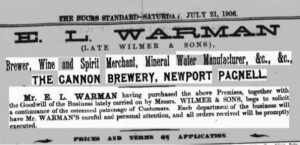
“E. L. WARMAN (LATE WILMER & SONS), Brewer, Wine and Spirit Merchant, Mineral Water Manufacturer, &c. &c. THE CANNON BREWERY, NEWPORT PAGNELL. Mr. E. L. Warman having purchased the above Premises, together with the Goodwill of the Business lately carried on by Messrs. WILMER & SONS begs to solicit a continuance of the esteemed patronage of Customers. Each department of the business will have Mr WARMAN’s careful and personal attention, and all orders received will be promptly executed. Prices and Terms on Application.”
There is one report of Edgar’s time in Newbury. It would seem he was a member of the Reading Lawn Tennis Club, competing in a tournament there in May, before coming to Newport.
So what immeadiate steps did keen sportsman Edgar take to get to know the workforce at his new brewery? He gave them a day off and organised a cricket match against rival Newport Pagnell mineral water & mustard manufacturer, Frederick William Taylor! I would imagine this idea went down very well with his new employees, especially after a long period of uncertainty as to whether their jobs would be safe. However, not only was this a match between rival firms, it would have been seen as a competition between strong liquor and abstinance, mirroring a movement that was taking place across the country at this time.
The event was covered in depth by the Bucks Standard of 18th August 1906:
“Mr. F. W. Taylor’s (Mineral Water Manufacturer) Employees v. Mr. E. L. Warman’s (Cannon Brewery) Employees. – This match was played in Bury Field, Newport Pagnell, on Thursday afternoon, August 16, when a pleasent game resulted in a splendid victory for Mr. Taylor’s side. Mr. E. L. Warman, with scores of 44 and 26, was the chief contributor to the Brewery totals of 69 and 56. C. Cavington was in fine form with his “daisy croppers,” taking, in the two innings, 16 wickets for 31 runs only. For Mr. F. W. Taylor’s side, Mr. Fred Taylor, jun., showed consistant form with the bat, his 58 not out being the result of dashing and stylish cricket. He received good assistance from C. Bavington (127) and E. French (16). Mr. Warman and Hill were the most successful Brewery bowlers. The scores are set out below [omitted], and a report of the subsequent post prandial proceedings will be found in another column.”
MR F W TAYLOR’S AND MR. E. L WARMAN’S EMPLOYEES AT CRICKET AND DINNER. The employees of Mr. F. W. Taylor (mineral water manufacturer) and of Mr. E. L. Warman (late Wilmers and Sons), brewer, mineral water manufacturers etc, were given their annual holiday on Thursday, August 16. In the afternoon teams of fourteen a-side from each firm indulged in a pleasant and, at times, amusing game of cricket in Bury Field, Newport Pagnell, the result of which was a decisive victory for the mineral water hands. The Brewery, captained by Mr. Warman himself, in their first innings ran up a score of 67. Mr. Warman played a dashing game for 44, but the other members of the side failed to show any good advantage. The “Minerals” replied with a total of 103, the chief contributor being Mr. F. Taylor jun., who carried his bat for a splendid 58. In their second venture the brewery workers were only able to put together 56 runs, and of that number
Mr Warman scored 28. During the remainder of the time allotted for play, Mr. Taylor’s employees lost four wickets for 46 (Mr. Taylor, jun., 19) and thus gained the victory by the substantial margin of 10 wickets. Mr. A Ross and Mr. H. C. Mapley umpired the game, and during the afternoon refreshments were provided for the men by the hands of two firms.
In the evening the employees were entertained to dinner at the Anchor Hotel, a well-prepared and excellently served spread being thoroughly enjoyed by a company numbering near upon 50, the catering of Mr. And Mrs. A Rose giving the greatest satisfaction. The chief chairs were occupied by Mr. F. W. Taylor and Mr. E. L. Warman, and under their genial guidance the proceedings were throughout of a most enjoyable character. Among those present were Mr. F. Taylor, jun., Mr. G. H. Sampson, Mr. R. Linthwaite, Mr. W. E. Cooks, Mr. T N. Wolsensroft etc.
Following dinner the loyal toasts were duly honoured, after which Mr. E. L. Warman proposed, in felicitous terms, the health of Mr. Taylor and his men, to whom he offered his congratulations on their victory in the cricket field. He gave it as his opinion that the best team had won.
The toast was enthusiastically received and musically honoured, and in the course of a happy reply Mr. Taylor thanked the brewery employees for their kindness. Referring to the cricket match he said it was impossible for both the teams to win, but he agreed with Mr. Warman that the best team had gained the victory. The cause of his (the speaker’s) men winning was that they fielded better perhaps than their opponents, but at the same time he was compelled to admit that the fielding on both sides was not brilliant 9laughter). As a spectator he enjoyed the game immensely, and, he hoped that another year the luck might change and the other side win, because it was a pity for one team to always carry off the laurels of victory. (Hear, hear). Continuing, he offered a hearty welcome to Mr. Warman on his coming to reside in Newport Pagnell, and he hoped he would be spared many years to live among them. He had no doubt that Mr. Warman would follow the late Mr. Wilmer’s footsteps and be a very useful and active man in the town (applause.) The speaker asked his men to drink to the good health of Mr. Warman and the losing team. If they played next year, he hoped they would see some big scores made by the members of both teams, so that it might not be “a one-man show.” The under-hand bowling had proved disastrous to many members of the two teams, but on another occasion they might have developed a round arm delivery which would be more acceptable. (Laughter and applause).
The toast was musically honoured, and in a brief response Mr. Warman expressed the hope that he should not disappoint them in his future career in the town, but that his actions would be met with general approval. (Applause).
Mr. H. C. Mapley next proposed a hearty vote of thanks to Mr. Taylor and Mr. Warman for their kindness in entertaining them that evening, and for giving then a half-day’s holiday. This thoughtfulness was humbly appreciated by the men, and that the masters were considerate of the best interests of their employees was shown by their presence in the cricket filed and at the festive board (applause). The toast was received with cheers and the singing of “For they are jolly good fellows.”
Mr. Taylor thanked them for the kind reception of his name, and spoke of the pleasure it had afforded him to assist towards the little holiday which he hoped would be an annual affair (Hear, hear). It was very nice for the two firms to join together and have their holiday in that way. His men had worked well during the busy months of the summer, and he was happy to be able to make some little return to them (Applause).
Mr. Warman endorsed the remarks of the previous speaker, and remarked that since he had taken over the business of the Cannon Brewery his men had worked well. Although he was a stranger still amongst them, he hoped he would not be a stranger very long, (Hear, hear).
During the evening a capital programme of songs was contributed to by Messrs T. N. Wolsencroft, S. T. Cook, H. C. Mapley, Joseph West, Albert West, H. Daniells, H. Grange, H. Henson, Payne, and C. Lake. Phonograph selections also added to the interest of the programme. Besides ably playing the pianoforte accompaniments, Mr. C. K. Garrett gave a couple of excellent musical sketches. The interesting proceedings were brought to a close at 11 o’clock by the singing of “Auld Lang Syne,” and “God Save the King.”
Despite the thrashing on the field of play, it seems they spent an enjoyable evening together. This introduction to his employees completed, Edgar began to take part in other social affairs of the town. The same month, he was already playing for the Newport Pagnell town cricket team.
According to the Bucks Standard of 27th October 1906, Edgar was present at a Conservative & Unionist Party function to present Mr. & Mrs. William Walter Carlile with a silver bowl. This was in recognition of Carlile’s 10-year service in the House of Commons as the Conservative M.P. for the Buckingham (or Northern) division of Buckinghamshire.
On 8th December the same paper reported he sent his regrets that he was unable to attend the Newport Pagnell Fat Stock dinner being held at the Swan Hotel.
1907
After a few months gap, his name appears in print again when he attended a North Bucks Conservative Association political smoking concert at the Swan Hotel. (Bucks Standard 13th April 1907)
As well as barrels, the brewery and mineral water works would have produced their wares to sell in bottles or flagons and many varieties of such which can still be found marked “Wilmer’s, Newport Pagnell”. Yet there are very few with Warman’s name on. He must have just continued to use the old stock. However, he did have some ginger beer bottles printed up with his name on, some glass bottles, including crown-top pop bottles and flat spirit flasks and flagons for larger quantities.
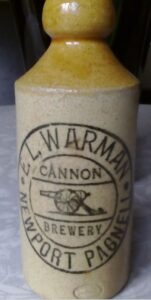
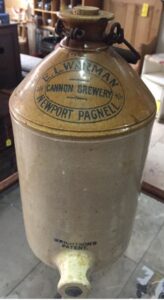
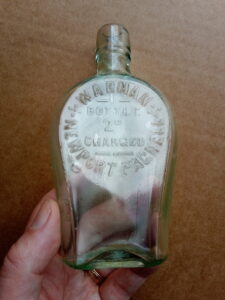
Inviting the local newspaper for a visit to the brewery paid off very well, with over a column of free publicity (unless the reporter had been slipped a few bottles for his trouble…) in the Bucks Standard of 11th May:
“A VISIT TO THE CANNON BREWERY, NEWPORT PAGNELL. BY OUR OWN REPORTER. The Cannon Brewery, Newport Pagnell, is one of those business institutions which, owing to its long connection with the respected Wilmer family, conjures up many pleasant memories and brings to the minds of the older inhabitants of the town and neighbourhood happy recollections of the days that have gone. As in private life so is it with business enterprises, the lapse of years brings changes, and in regard to the brewery establishment with which we are dealing this truism is particularly applicable. Some few months ago the late Mr. Wilmer’s executors disposed of the business to Mr. E. L. Warman, a young man with a wide and varied experience of brewing in all its details; a man, too, with a keen business insight and who, during the brief period of his proprietorship, has effected these improvements which modern requirements and the increasing competition of today demands. In the brewery itself, which has lain idle for a considerable period, is Mr. Warman’s up-to-date ideas most pronounced, and a representative of the “Bucks Standard,” who during the present week visited the plaice, was wonderfully impressed with the improvements which had been made.
In order to carry out his work of brewing successfully, and to ensure patronage, Mr. Warman has installed an entirely new plant, which has been laid down on the modernist of modern principles, by Messrs. Adlam and Sons, the well-known brewer’s engineers, of Bristol. The structural alterations were placed with Messrs. Wilford, Bros., a well-known local firm of builders and contractors, whose work has been carried out in a manner entirely satisfactory. What struck the writer more particularly in going over the premises was the spotless cleanliness of that portion in which the brewing is done. Not a spot of dirt was to be seen anywhere, and everywhere it was apparent that Mr. Warman is determined that his beer shall be produced under conditions with which a fastidious public can possibly find no fault. In brewing, which, by the way, was only very recently commenced, the water plays a very important – the all-important – part, and it will interest the public to know that Mr. Warman has given every attention to this department of his business. The water used is pumped from a wall beneath the cellars, and quite recently was declared by a public analyst to be absolutely pure, and more adaptable to the brewing of a good and palatable beer than that which is need in many of the large breweries of the kingdom.
With his own experiences in four breweries Mr. Warman is convinced that, whatever the capabilities of the brewer, if the water is not up to the standard, the results obtained are far from satisfactory. It was the tank containing the “liquor,” or brewing water, which we first inspected, and from there we went through all the various processes till we reached the yeast “back.” Yeast also is an important factor in the production of good beer. Unless a good, genuine and healthy yeast is used one might as well endeavour to produce beer from chalk and water; the result would be none the worse. Here again Mr. Warman is displaying his business insight by procuring this essential article from Messrs. Charrington and Co., of Barton-on-Trent, who are recognised as being the best yeast makers in the world.
Reverting again to the liquor tank, the water used is of such a high standard of purity that it needs no scientific treatment of any kind. In this respect the proprietor of the improved and in every respect modernised Cannon Brewery is very fortunate, as it is a well-known fact that many breweries have a great difficulty in obtaining water which will do its work without chemical treatment. Mr. Warman is a strong believer in pure beer, and is confident that the least chemical matter that is introduced into beer the better is it not only for the brewer but for the public also. In this respect it might he mentioned that the brewing trade, from the scientific point of view, have made such advances the last fifteen or twenty years that they have – in certain cases – and we might say in the majority of cases – that the treatment of liquor and the addition of chemicals make it possible to produce a better beer, and furthermore a beer eminently more satisfactory to the public. Bearing this in mind Mr. Warman does not thank a system of so-called pure beer would prove acceptable in every case. The beer drinking public requires something more than malt and hops will produce.
As one visits various breweries, he notices different systems adopted, if only in a very small detail, and every practical brewer has his own particular method which, more or less, produces the same results. But, as it was pointed out to our representative, one brewer cannot imitate another in exactly all his methods and be equally successful. To proceed with our wanderings over the brewery under notice we were also shown the hot “liquor” tank, made of copper, also spotlessly clean. The malt mill is on the same floor and is an interesting piece of machinery. And here it was explained that the malt is crushed the day prior to the brewing taking place. The malt having been crushed, “mashing” is the next process, and in order to do this the “liquor” has to be heated to a certain temperature. The “mash” having stood for the necessary period, the taps set, and then started what is started what is technically termed “sparging.” A certain quantity of liquor is run through the main liquor pipe and is received into the mash tub. This is done by means of a ball-bearing “sparge” which keeps up a continuous flow. It then passes into the copper when the boiling process is proceeded with.
When the boiling is completed the liquor is transferred through pipes to the “hop back.” This has false bottom plates which keep the hops back from the wort which drains through the perforated plates. From the “hop back” the recently boiled wort is transferred to the cooling vessel, and subsequently into the cooling tun. The methods of cooling and fermentation adopted by Mr. Warman are quite up-to-date. The beer remains in the fermenting tuns for periods which vary according to the quality required and the season of the year until it ready for draught. The malt store, sugar room and the hop room, in which were stored many pockets of Kentish bops, were also visited. The“racking”process adopted by Mr. Warman is of the most modern character and allows of no sediment going into the vats in which the beer is stored. Mr. Warman has a very fine stock cellar containing every conceivable kind of wines and spirits of the most reliable vintage and brand.
A mineral water factory is also attached to the brewery, and the dry ginger ales and lemonades manufactured by Mr. Warman are recognised as of excellent quality and a palatable and refreshing summer drink. It is no exaggeration to state that the Brewery is now one of the best equipped in the county, whilst the conditions under which brewing is conducted are such that the public may confidently rely on Mr. Warman supplying them with a beverage which if it can be equalled can certainly not be surpassed.”
On 1st June, the Bucks Standard reported Edgar had attended a complimentary dinner at the Swan Hotel on the occasion of Mr. and Mrs. J. Taylor, and also Mr. T. N. Wolstencroft, leaving the district. Mr. Wolstencroft had run the Swan Hotel for the last 10 years.
Towards the end of the month, a meeting was held in Newport with a view to creating a “greater interest in the evening school organisation”. Edgar could not be present, but sent in a letter saying that he “should be most willing to give every assistance in order that the object desired might be achieved.”
In connection to his political beliefs, he attended a Primrose League fete and was a judge at their Old English Sports, Gymkhana & cycle events. (13th July 1907, Bucks Standard) The Primrose League was a support organisation for the Conservative Party, given that name as the primrose was known to be the favourite flower of Benjamin Disraeli.
In August, he was advertising his products in the Bucks Standard:
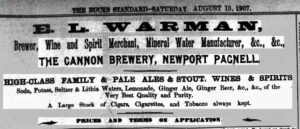
“E. L. WARMAN, Brewer, Wine and Spirit Merchant, Mineral Water Manufacturer, &c. &c. THE CANNON BREWERY, NEWPORT PAGNELL. HIGH-CLASS FAMILY & PALE ALES & STOUT, WINES AND SPIRITS. Soda, Potass, Seltzer & Lithia Waters, Lemonade, Ginger Ale, Ginger Beer, &c. &c. of the Very Best Quality and Purity. A Large Stock of Cigars, Cigarettes, and Tobacco always kept. PRICES AND TERMS ON APPLICATION.”
During October, he was in the audience at a Liberal Unionists meeting at Newport, to discuss the proposition that “Tariff reform was the only salvation of the working classes”, and he also supplied some prizes to the locally-contested Lathbury Challenge Cup for rifle shooting. The next month, a major reorganisation of his business saw the setting up of a company to run the brewery. The Board of the new company were all Edgar’s close family and was reported in the Gloucester Citizen (15th November 1911) back home where they still lived in Stroud:
“Local Company. WARMAN AND CO. LTD. This company has just been registered with a capital of £3,000 in £1 shares, to acquire the business carried on at Newport Pagnell, Bucks, as “E. L. Warman’s Cannon Brewery,” to adopt an agreement with E. L. Warman, and to carry on the business of brewers, ale, beer, porter, wine and spirit merchants, aerated water manufacturers, cigar and tobacco dealers, etc., etc.
The subscribers are:-
Warman, The Woodlands, Stroud, solicitor 1
Mrs. M. E. Warman, The Woodlands, Stroud 1
F. B. Warman, 4, Whitehall, Stroud, solicitor 1
Mrs. H. Warman, 4, Whitehall, Stroud 1
D. S. Warman, The Woodlands, Stroud, architect 1
Miss. M. E. Warman, The Woodlands, Stroud 1
I. Greening, Rose Tree Villa, Kings-court, nr. Stroud, clerk 1
No initial public issues. The number of directors is not to be less than 3 nor more than 5; the first are W. Warman, E. Parfitt, E. L. Warman, and W. F. B. War4man. Qualification, 250 shares. Remuneration (except managing director) £50 per annum, divided. Registered office: 51, High-street, Newport Pagnell, Bucks.”
The 14th December Bucks Standard reported on the Newport Pagnell Christmas Market and Fat Stock Show, where Edgar was noted as having given valuable assistance to the judges and proposed a toast to them at the meal at the Swan Hotel afterwards. Then, at the very close of the year, in the 28th December Bucks Standard, news broke that the brewery was losing one of its most experienced employees. Under the headline “A Popular Public Servant”, it announced that Mr. George Sampson, Edgar’s Brewery Manager, was to leave the Cannon Brewery after 30 years residing in Newport Pagnell, to take a “very important appointment” for the Aylesbury Brewery Company. He had held a large number of public posts locally, including having sat on the Newport Pagnell Parish Council, until replaced by the Urban District Council, and then continued on that too. He was secretary to the trustees of the Town Lands (Feoffees) Board, and had been the local Registrar of Births, Marriages and Deaths for the last 11 years. More usefully to Edgar, Sampson was also secretary to the North Bucks Licenced Victuallers and Beersellers Protection Association, prominent local Freemason and treasurer of the North Bucks Conservative Association, a post he took over from his late employer, John Wilmer. He also served on the committee of the Newport Pagnell Rifle Club. (According to his obituary in November 1946, the job George had taken with ABC was that of was Company Secretary. He did very well for himself there, becoming a Director in 1922 and then Managing Director by the time he retired in 1934. He was still Chairman of ABC at the age of 86 when he died.)
1908
Although the setting up of a Company had already been advertised in Gloucester papers the previous November, it was February before the change was made official. A contract in the hands of the Cannon owners, dated 8th February 1908, shows Edgar, (who was still listed as of “The Mount, Newbury”) sold the Cannon premises and all goodwill etc. to the new company for £3,740. The Company office was listed as at 51, High St, Newport Pagnell. The ‘new’ brewery company advertised in the Bucks Standard in March:
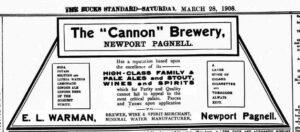
In April, a report appeared that he had taken part in a “Great Meeting” of protest to the Government’s proposed Licencing Bill, held at Newport Pagnell Town Hall, where he was on the stage with some other local brewers. A large number of temperance supporters were in the audience, but a resolution of condemnation was eventually passed. Several present objected to the figures given of expected job losses and numbers of pubs that would have to close, in a noisy and argumentative meeting. (Bucks Standard, 4th April 1908)
On 23rd May, the Bucks Standard ran a report of a court case where the executors of John Wilmer brought an action against Mr Alfred Sparks, farmer, Broughton; Mr. S. Boswell, Boot Inn, Olney and Mr. George Norman, farmer, Wolverton. These were just three of a number that still owed the estate for goods they had received. After Wilmer had died, Mr. Sampson and his co-executor had run the business until it was sold to Warman, but it was agreed that Warman should try to collect the debts, with interest. This he had not done, as he was “…probably not desirous of offending old customers of the firm, and wishing perhaps to retain their business, Mr Warman did not over exert himself in the matter, and it was subsequently taken out of his hands and placed with the executor’s solicitors.”
Edgar felt wronged to have his name included in the report this way and whatever his good relationship with the local press prior to this, felt compelled to write to the paper for the next week’s issue:
“A Disclaimer. To the Editor of the Bucks Standard. Dear Sirs, – I notice in your issue of the 23rd inst. in the report of the Newport Pagnell County Court proceedings, my name is mentioned in connection with certain actions brought by the Executors of the late Mr. J. E. Wilmer.
I consider it was quite unnecessary that my name should have been mentioned in Court at all, as it did not affect the points at issue, and in order to correct an impression that has arisen in certain quarters, I should like to take this opportunity of informing the public generally through your columns that I had nothing whatsoever to do with the actions brought by the said Executors, noir shall I have with any future proceedings they may think fit to take in the future. Yours faithfully, E. Leslie Warman, The Cannon Brewery, Newport Pagnell, May 29, 1908.”
He attended a Primrose League gathering at Mr. Carlile’s property at Gayhurst. It was a small gathering, where they denounced the Education Bill and Licencing Bill. (Bucks Standard 19th June 1908). The Buckingham Express of 27th June added that Edgar had been on the Organising Committee for the event.
Edgar sent his apologises for not attending the North Bucks Conservatives meeting at the High Street Schools, Fenny Stratford, where they discussed the case for Tariff Reform. (Bucks Standard, 27th June 1908) Then he successfully bid for a contract to supply the Newport Pagnell Board of Guardians with porter at 10d per gallon, port wine at 12s., and pale brandy 24 u.p.[?] at 24s. (Bucks Standard, 26th September 1908)
Although I imagine recent business dealings had taken up much of his time, he had still found energy for some sporting activity. The Bucks Standard, 3rd October:
“Golf Competition. – The members of the Newport Pagnell Golf Club, on Thursday, October 1, took part in the competition for the handsome silver vase, kindly presented to the club by the Rev. J. B. Maul. The conditions were 36 holes and the players, who were handicapped, had to make four rounds of the links. The result was a tie between Mr. G. F. Trimmer (handicap 18) and Mr. C. H. Glanville (handicap 18) who each made a net score of 160. Mr. E. L. Warman (handicap 12) was next with a net score of 167. The tie was played off early this (Friday) morning, when Mr. Trimmer won and thus secures possession of the valuable prize.”
Towards the end of the year, he received very sad news from back at the family home in Stroud, as his brother, Bertie, had died of double pneumonia on 13th November, aged just 22. He was an architect, and had been in Demerara, British Guiana, working for a sugar plantation, but had returned home due to ill-health a year before. Edgar went back to Stroud to attend the funeral. It was mentioned in the obituary that their father, William, had been ill for some time too.
1909
Edgar was part of the Bury Field Committee when they met to consider removing a tree. (Bucks Standard, 13th February 1909). This was most likely in connection with the local Golf Club, who used Bury Field as their course. Once the days began to get a little lighter, he was back out playing golf again. He was the ‘A’ Class winner in the monthly Silver Spoon competition over 18-holes on Saturday 1st May at Newport Pagnell Golf Club (Bucks Standard, 8th May 1909)
In July, he presented some of the prizes (liquid ones, I imagine…) to the Newport Pagnell Rifle Club for their annual contest. (Bucks Standard, 10th July 1909) and at the end of the month, he played in the Bletchley v. Newport Pagnell Golf Clubs match, beating the Rev. S. G. Finley by 6 and 4, although all the other five games went Bletchley’s way and they won out 5-1. (Buckingham Advertiser, 31st July 1909)
Mr. J. P. Goodwin, the estate agent and auctioneer of Newport Pagnell who had tried to sell the brewery at auction in 1905 passed away in August and Edgar was listed as one of the Brothers of the local Peter & Paul Lodge of Freemasons who attended the funeral. (Bucks Standard, 21st August 1909)
Then came disastrous news from Stroud. The family wanted their investment in the brewery company back! His father, William Warman, was gravely ill and I imagine the elder sibling, William jnr., had taken control of the business finances. Perhaps he disapproved of Edgar’s venture in Newport Pagnell? Or perhaps the family firm was in financial difficulties itself and needed the money? Whatever the reason, there was no way that the Ltd. Co. could repay the investments made into it just 18-months before. There must have been some to-ing and fro-ing between Stroud and Newport Pagnell about the decision, but on 20th August 1909, a contract of bankruptcy was signed. This is one of the deeds in the hands of the current owners of the Cannon. “William Warman of Stroud, Gloucestershire, gentleman, is the principal shareholder in the company, holding shares numbered 1-60 and has given notice that he requires the principal money to be repaid to him, the company does not have enough funds, and therefore Mr. Stephen John Dudbridge is appointed to liquidate the business”.
Perhaps initial talks had already taken place, but a sale was very quickly arranged and just seven days later, on 27th August 1909, there is an agreement by William Warman and John Dudbridge to sell the “Premises, Plant, equipment and Goodwill” to the Aylesbury Brewery Company, who had recently employed the ex-Cannon Brewery manager, George Sampson. I wonder if he had come knocking, or if Edgar had contacted him? Perhaps it was the plan when the brewery company was set up. I suspect we will never know.
The official transfer took place on 20th September 1909. The sale of the Cannon premises, the business, all plant etc. and the goodwill raised £2,138. The deed recites that the company was incorporated on 11th November 1907 and that on 19th December 1907, William Warman received 60 shares valued at £100. He was to receive 4% dividend per year and the shares to be repurchased by the company on 31st December 1912. The company did not have the funds to repurchase the shares and therefore William appointed Dudbridge as Receiver. The company, its premises, plants and goodwill were sold to the Aylesbury Brewery Co., along with the rights to use the names of ‘Wilmer & Sons’ and ‘Wilmer & Co. Ltd’.
Two days before that deed was signed, ABC were already proudly advertising their acquisition:
“The Aylesbury Brewery Company, Ltd. Cannon Brewery, Newport Pagnell. The Aylesbury Brewery Co. Ltd. beg to inform the inhabitants of Newport Pagnell and District that they have purchased the Business of Messrs. Warman & Co. Limited, of the above address, which was formerly carried on for a considerable period by Messrs. Wilmer & Sons. The Business will be conducted under the direct supervision of Mr. George H. Sampson (who for so many years was Manager for the late Mr. John R. Wilmer), and Mr B. Linthwaite will represent the Firm as Resident Manager. Telephone no. 42, P.O.”
And where was Edgar on the very same day as his Brewery was being taken over? At his golf club of course! He was taking part in the Allison Cup at the Newport Pagnell Golf Club, where he came sixth. This was obviously the place for local-drinks-firm’s owners to be, as Mr F. W. Taylor came third and Mr. F. Allfrey, of the Newport Pagnell Brewery Company, came seventh. (Bucks Standard, 25th September 1909)
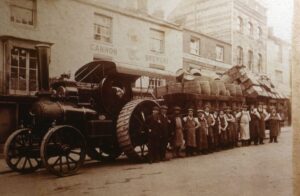
The licence for the Vaults had to be transferred too:
“The Wine and Spirit Vaults, High-street, Newport Pagnell, were transferred from Mr. E. L. Warman to Mr. G. H. Sampson (Aylesbury Brewery Company). Chairman [J. M. Knapp Esq.] to Mr. Sampson – Are you going to live on the premises? Mr. Sampson – Yes, partly, and Mr. Laithwaite. There will, however, always be a responsible person on the premises, and one approved of by Superintendent Lait.”
The Cannon pub was originally called the ‘The Wine Vaults’. Once ABC took it and added their branding to the building, it was known locally as ‘The ABC’ and also ‘The Gin Shop’. Surprisingly, it only changed its name to ‘The Cannon’ in 1953. The name comes from a cannon that is presumed to have been left in Newport after the English Civil War, first recorded in 1740. Actual brewing is thought to have ceased on the site after Warman left, as ABC brought their own beer up from their brewery at Aylesbury. The 70-foot brewery chimney was demolished in 1958 and then most of the original brewery buildings behind the pub in the 1980’s.
On 3rd December, Edgar’s father, William Warman, died in Stroud at the age of 71. He had been a solicitor since 1860 and built up his own firm of Warman and Son. He had held many positions in local Stroud life, including having been a prominent Freemason, clerk to the Board of the Stroud Union, and until a year before his death, Superintendent Registrar for the Union. He was staunch Conservative and loyal Churchman. A large funeral was held, which Edgar attended. The legal firm carried on under Edgar’s elder brother, William jnr.
1910
There is only one further mention of Edgar in connection with Newport Pagnell, that of the Golf Club having to find a replacement for him on their committee, which they did in the person of Mr. G. Taylor. (Bucks Standard, 5th February 1910)
At the brewery, ABC choose to resurrect the Wilmer’s name and trade on the fond recollections of local customers. As early as 11th June 1910 in the Bucks Advertiser, they were advertising:
“IMPORTANT!! THE AYLESBURY BREWERY COMPANY LTD, BUCKINGHAM are now in a position to supply Wilmer’s celebrated Newport Pagnell Mineral Waters. The purity of these waters are assured, and the following report has been made by the well known analytical Chemist, Mr. Granville Sharpe:- Analytical Laboratory, 11. Queen Victoria Street London E. C. May 28th 1910 Certificate of Analysis I hereby certify that I have analysed and examined the “Soda Water” supplied by Messrs. Wilmer and Son of Newport Pagnell. It had been prepared from a natural water of a high degree of purity with pure “bicarbonate of Soda” and well charged with carbon-dioxide gas. It was genuine Soda Water in the strictest sense – not merely tap water charged with gas. I can certainly commend this as a thoroughly genuine wholesome rand of Soda Water. (signed) Granville H Sharpe. Our Mineral Water Vans deliver daily. Soda Water, Potash, Seltzer, and other Waters, Ginger Beer in Stone Bottles, Spruce, Lemonade, Dry Ginger Ale etc. etc.”
The name “Wilmer’s” was still in use in 1924 when ABC published a price list of their wares. ABC considered restarting brewing at the site in 1981, with capacity of 100 barrels a week, but eventually decided against it.
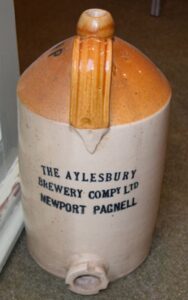
1911
Another census took place this year and Edgar is listed as a resident back at the family home, Woodlands, in Stroud. He gave his occupation as “Brewer”, and was living with his mother and sister Muriel until she married in September. The Gloucester Chronicle on 30th December 1911, in a look back at the local events of the year, referenced the September 27th wedding at Holy Trinity Church, Slad, near Stroud, of Mr. Ernest Victor Jones of Wolverhampton, to Miss Muriel Eileen Warman, of the Woodlands, Stroud.
1912
In the 1912 Register of Electors, he was listed as being eligible to vote in Stroud, but it gave a new address. He was now living at Church House, Heavitree, Exeter.
All these press reports use only the name “E. L. Warman”, but given the uniqueness of the name and the connections to the Conservative party and sporting events, they must have been him. An E. L. Warman took part in amateur theatrical production for the local Conservative party. (Exeter & Plymouth Gazette, 20th January 1912). An E. L. Warman played in Gentleman’s Open Singles at the Victoria Park Tournament, a Lawn Tennis competition. (Exeter & Plymouth Gazette, 2nd August 1912). An E. L. Warman competed at the Warren Golf Club, winning the mixed foursomes. (Exeter & Plymouth Gazette, 14th October 1912)
1913
The 1913 Register of Electors give the same address for him this year. In the press, an E. L. Warman attended the Heavitree Brewery Coal Club meeting for a presentation to the Head cellar-man, Mr. Warren. (Exeter and Plymouth Gazette, 3rd February 1913). In March, E. L. Warman represented Heavitree Brewery at a meeting of West Country brewers, called the Operative Brewers Guild. (Western Times, 13th March 1913). An E. L. Warman served as a juryman at the inquest into the execution of a convicted murderer, George Cuncliffe, who was hanged at Exeter Prison. (Exeter & Plymouth Gazette, 26th February 1913). An E. L. Warman won the Iddesleigh Cup at Exeter Golf Club. (Exeter & Plymouth Gazette, 26th March 1913).
1914
At some point between March 1913 and June 1914, Edgar had moved to Southsea, Portsmouth. The Register of Electors gives his address for 1914 as no.31 Clarence Parade and there he became betrothed to Miss Glencora Isabell Hamilton, the daughter of retired Royal Navy Deputy Inspector General. This news made it into The Tatler in June – “Miss Cora Hamilton. Eldest daughter of Deputy – Inspector – General Stewart F. Hamilton, R.N. (retired), and Mrs. Hamilton of St Aulkman’s, Southsea, who is marrying Mr. Edgar Warman, second son of Mrs. Warman of Stroud, Gloucestershire.” and as far away as the Dublin Daily Express in September. In October, the Hampshire Telegraph said the wedding would take place “quietly” on the 7th that month, in deference to the fact that England was now at war.
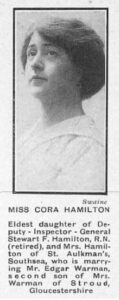
However, it seems the ‘quiet’ wedding was still quite decorative and well-attended. The Portsmouth Evening News of 7th October, under the headline “Smart Southsea Wedding”, describes the large congregation and the chancel of the church decorated with tall palms, arum lilies and chrysanthemums. It continues:
“The bride…looked particularly well in a pleated tunic of deep champagne suede cloth, over an underdress of kingfisher-blue velvet. Similar velvet formed the pointed waistbelt and trimmed the sleeves, the bodice being completed by a vest and wrist frills of real Limerick lace. She wore a large hat of kingfisher-blue silk Bengaline, with a circlet and high mount of ostrich feathers to match. Her only adornment was an aquamarine and pearl pendant, and a cluster of white carnations and white heather was tucked into the front of the dress.”
Edgar’s uncle, the Rev. J. S. Warman, Rural Dean of Boxford, conducted the service, in conjunction with local Rev. Vickers. Edgar’s sister’s husband acted as Bestman and there were no bridesmaids. “Owing to the war…” only relatives and a few friends went to the Hamilton’s residence to celebrate, after which the happy couple left for a New Forest Honeymoon. A later edition had a complete list of the presents they had received.
1915
Edgar did not volunteer at the start of the war, and was still living in South Sea in 1915, now at no.22 Pelham Road, presumably with his new bride.
1916
With increasing demands for men for the armed services, Edgar finally joined up and, possibly under the advice of his father-in-law, opted for the Royal Navy. His Navy record has survived at the National Archives (ADM 196/97/50). Edgar became a Royal Marine, 2nd Lieutenant with a Temporary commission on 5th February. By September he had completed his training at Fort Cumberland, Portsmouth and was sent to France assigned to the Royal Marine Artillery.
The Long, Long Trail, Chris Baker’s website dedicated to research of the First World War, gives some further information on Edgar’s unit:
“The RMA guns were strange misfits, owing their existence to the private enterprise of the Coventry Ordnance Works and their presence in France to the First Lord of the Admiralty, Winston Churchill. The Coventry Works had designed and built the modern 9.2″ howitzers, which had first arrived in France for the RGA Siege Batteries in November 1914 and, after the success of this equipment, had on their own initiative decided to build something altogether bigger and more powerful. Thus was born the 15-inch Breech Loading Siege Howitzer, which had a maximum range of 10,795 yards (6.13 miles), firing a 1,400 pound (more than half a ton) shell. In order to gain acceptance within the military establishment, a Coventry Ordnance Works Director, Admiral Bacon, exploited his connections with the Admiralty in order to affect an introduction to the Ordnance Board of the Army. Churchill, as was his wont, intervened. Spotting an opportunity for the Navy to get embroiled in the action on the Western Front – as well as sensing a good story for the press – Churchill manned the first gun with a team of Royal Marine artillerymen and sent them post haste to France. They would be followed by another eleven of the 10-ton 15 hundredweight behemoths. Churchill’s enthusiasm for his Royal Marine Artillery soon waned and the twelve howitzers were turned over to the army. When approached by the Director of Artillery for further information about these unwanted ‘gifts’ the Ordnance Board commented acidly “These equipments were obtained by the Navy in direct negotiation with the manufacturers, and the Board was not consulted. In view of the poor range achieved, it is felt that these weapons are a waste of money and material”.”
The gun was affectionately named “Grandmother” by the RMA crews, also called “Grandma” or “Granny”. A total of 88 men were assigned to each gun, a Commanding Officer (Captain or Major), one Gun Officer, two Observing Officers, a Motor Transport Officer, an Artificer, a Battery Sergeant-major, a Battery Quartermaster Sergeant, 55 NCOs and men and another 25 drivers!
10 RMA crew loading a 15-inch gun near Menin Road, Third Battle of Ypres. 5th October 1917 (Google Images)
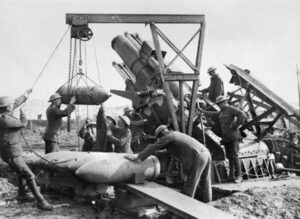
The design allowed for the dismantling and reassembly of the gun and the platform it was mounted upon for firing. To transport the gun and necessary equipment required a fleet of 11 trailers, two of which carried the ammunition. The trailers were not motorized, therefore, they required five specially-built Foster-Daimler 100-HP tractors, each pulling two or three trailers. On a good day, on firm ground, it would have been a quite a task setting up one of these monsters. Add continuous rain, a rough shell-cratered landscape, with incoming shells and bullets!
In August 1915, no.1 gun and its platform were dismounted in 4½ hours. The platform was remounted in 2½ and the gun in 3½ hours. It is not stated if this time included the digging of the required 2 foot by 21 foot platform pit.
During firing, the gun would rock backwards and sometimes slew to the side. Run-back could be as much as one foot for each round. This had the effect of bulldozing a mound of earth three to four-foot-high behind the gun at times. This caused extra work for the crews keeping it clear, usually by one section while another fed and fired the gun. In one extreme case, the platform ploughed back 90 feet, going completely through a small road. Slewing caused aiming problems as there was only 36 degrees of train each side of the centre line of the gun. The crew’s innovations in the field went a long way to solve the problem using wire hawsers around suitably sized tree (if any could be found) or sinking anchor points into the ground. Another method was to select a new target in the opposite direction and trust the recoil would slew the gun back on line with the first target! Slewing and run back only occurred in soft ground. A well mounted gun on good ground proved satisfactory and accurate.
Accuracy was the responsibility of the Observation Officers from their OP (observation post) usually in the forward trenches and at times up to 200 yards in front of the lines. This duty meant taking rations for five days and staying at their post night and day.
There is almost three minutes of archive film of the RMA operating one of the guns at the Battle of the Somme here: https://www.criticalpast.com/video/65675048366_British-soldiers_Battle-of-Somme_15-inch-Howitzer_shells-lined-up Early shells had very unreliable fuses, and many did not explode. One artillery officer said there were so many 15″ ‘blinds’ (unexploded shells) that it was possible to use them as cover in no-mans-land. During intensive bombardments in August 1916, a 15” gun fired 15 or 16 rounds in an hour and could keep up this rate for at least two hours.
1917
Edgar’s military record states he had taken part in the Battle of the Somme to January 1917 and then got home to England for 10-days leave, before returning to France for a 3-week signals course in February. On the second day of the course, news came through that he had been promoted to a full Lieutenant. He then took part in the Battle of Vimy Ridge.
In July, he was admitted to a Red Cross hospital with Trench Fever, a highly contagious rickettsial disease transmitted by lice and it became serious enough that he was shipped home to England for the rest of the year.
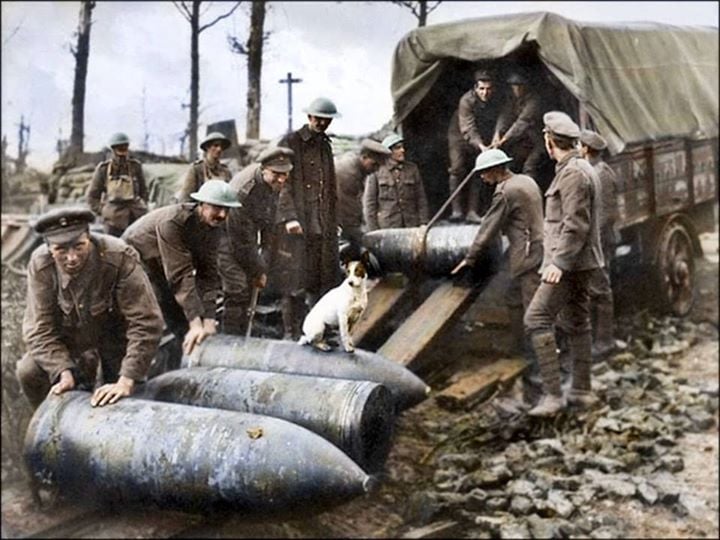
1918
By January 1918, he had recovered enough to return to the Frontline, assigned to No. 1 Gun as an Observing Officer on 26th January. I have not seen the relevant war diaries at the National Archives (ADM137/3072 & 3073), but there are some excerpts from them online. The history of No.1 Gun is discussed at length by Mike Guest, posting on the online Great War Forum. For mid-August 1918, it records:
“Arrived on 12th at Authie; Mounted & standing by; Target Pusieux.”
The town of Pusieux stands just west of Bapaume and Authie is nine miles further to the west, making it out of reach of the gun, so they must have been positioned closer to bring it into range. “Standing by” was a term used for shooting at targets, but not a heavy continuous bombardment. Then the next entry for 8th August:
“August 1918, Authie; Lt. Warman killed & Corporal Woodard wounded while in OP”. [Observation Post]
B. A. Woodard, from Fratton, was injured so badly that he lost a leg. Edgar was laid to rest in Bienvillers Military Cemetery, which contains 1,605 Commonwealth burials and commemorations of the First World War. News of his death was reported by the Hampshire Independent on 24th August 1918.
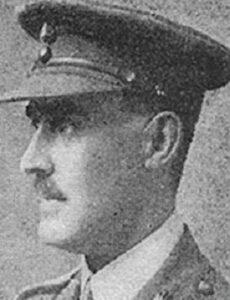
The Commonwealth War Graves Commission entry for him reads:
“Lieutenant WARMAN, EDGER LESLIE Died 08/08/1918. Aged 38. No.1 Gun, Howitzer Brigade. Royal Naval Division. Royal Marine Artillery. Son of the late Mr. and Mrs. William Warman, of Stroud, Gloucestershire; husband of Glencora Isabel Warman, of 33, Junction Road, Southsea, Portsmouth.”
[Junction Road was renamed Wimbledon Park Road in the 1930’s. I’m sure Edgar would have approved of the sporting connection.]
The CWGC also records that Cora asked for “UNTIL THE DAY DAWN AND THE SHADOWS FLEE AWAY.” to be engraved on his grave stone. When probate was granted, Edgar had left just £227 3s. to his widow. His Victory and British War Medals were sent to her. His photo was included in the “Roll of Honoured Dead” in one of the volumes of “The War Illustrated“.
After the war, his original Graves Registration Unit battlefield cross was rescued and returned to England, where it survives in the Bradfield College chapel. It reads “In memory of ROYAL MARINE Lieut. E. L. Warman. Killed in Action 8-8-18.” On bearer arms “ROYAL MARINE ARTLLY B.E.F.”
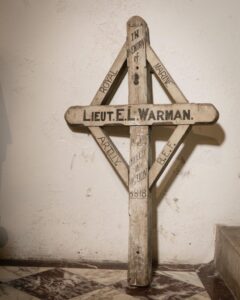
Edgar’s name also appears on the World War 1 Roll of Honour (Panel 12) on the memorial to the Royal Marines at their Museum at Eastney Barracks, Portsmouth. The Portsmouth Evening News of 9th August 1920 had an In-Memoriam notice from Edgar’s widow, Glencora:
“WARMAN – To the ever present and very loving memory of my darling husband (Billy) Edgar Leslie Warman (T.) Lieutenant, R.M.A., who was killed in France 8th August, 1918. “Until.” “
I have not been able to track down when it was installed, but a Memorial window was erected in St. Andrews Church, Eastley, dedicated to Edgar. The church was used as the Royal Marines church for many years, until it closed in 1973 and was converted to private housing 25 years later, but the window is still thought to still remain in situ. The text reads:
“IN SACRED MEMORY OF EDGAR LESLIE WARMAN, LIEUT, (T) R.M.A. KILLED IN FRANCE 8TH AUGUST 1918. PRO PATRIA*. ERECTED BY HIS HEARTBROKEN WIFE, RELATIVES AND THE OFF. & MEN of GUN 1.”
* Latin – “For the Fatherland”
At the age of 82, the death of Deputy Inspector-General Stewart Frazer Hamilton, Edgar’s father-in-law, was reported in the Hampshire Telegraph on 11th March 1932. The death occurred at no.33 Junction Road, Southsea, the same address that Edgar and Cora had used. Perhaps he had moved in with his daughter? Or had they lodged with him? He had been a Royal Navy Fleet Surgeon.
Edgar’s elder brother, William, died in April 1947, and his widow Hannah died in July 1949. Amongst her legacies, she left £1000 of Defence Bonds to Glencora I. Warman, Edgar’s widow. Glencora died in June 1969, aged 84, after spending the last 16 years of her life living at Beacon House, New Street, Painswick, just two and a half miles from the Warman family home at Woodlands, Stroud.
This research is dedicated to the memory of Lt. Edgar Leslie Warman, 12th April 1880 – 8th August 1918
Acknowledgements I am very grateful for the assistance of the following:
George Malcolmson, National Museum of the Royal Navy
Karen Ward, Bradfield College, Berkshire
British Newspaper Archives, www.britishnewspaperarchive.co.uk
Newport Pagnell Historical Society
Mike Brown, “ABC: A Brewers’ Compendium”, 2007 (Brewery History Society)
Buckinghamshire Archives, Aylesbury
Milton Keynes Library Service
Mike Guest on The Great War Forum www.greatwarforum.org
Chris Baker – The Long, Long Trail www.longlongtrail.co.uk
Page last updated Feb. 2023.
